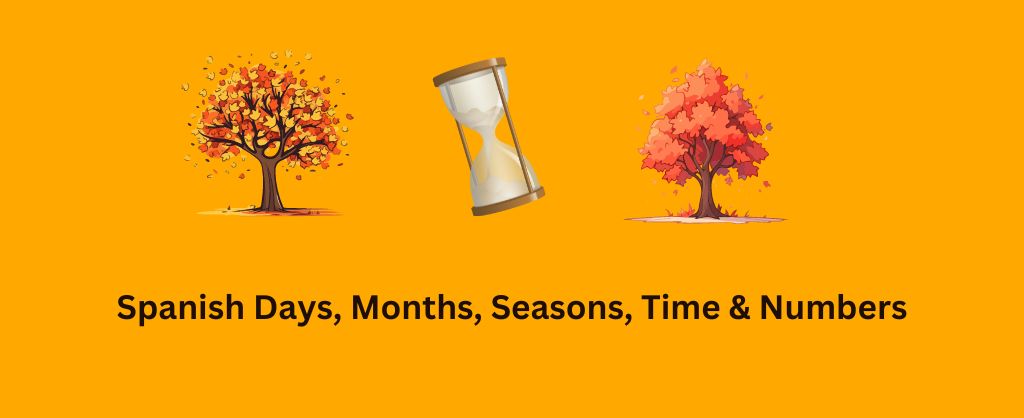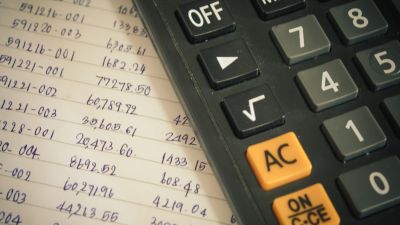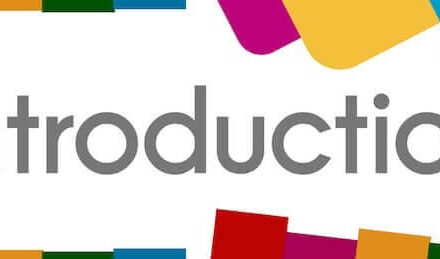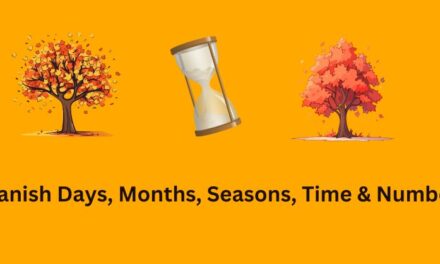Master Spanish Days, Months, Seasons, Time & Numbers

Learning how to say and understand days, months, time, dates, and numbers in Spanish is essential for beginner Spanish learners.
This comprehensive guide will teach you everything you need to know about these basics of the Spanish language in a simple and easy-to-understand format.
Days, Months, and Seasons in Spanish
Learning Spanish months, days of the week, and seasons provides a great foundation for discussing dates, schedules, weather, and time periods. In this section, you’ll learn:
- The 12 months in Spanish
- The 7 days of the week in Spanish
- The 4 seasons in Spanish (spring, summer, fall, winter)
You’ll learn the vocabulary for each month, day, and season along with example sentences so you can use them in context.
Los Días de la Semana (The Days of the Week)
To talk about the days of the week in Spanish, you need to know these words:
- Lunes – Monday
- Martes – Tuesday
- Miércoles – Wednesday
- Jueves – Thursday
- Viernes – Friday
- Sábado – Saturday
- Domingo – Sunday
It’s helpful to memorize these days of the week, as you’ll use them frequently when speaking Spanish. Try making flashcards or repeating them out loud each day.
Here are some example sentences using the days of the week:
- Hoy es lunes. (Today is Monday.)
- Mañana es martes. (Tomorrow is Tuesday.)
- Ayer fue domingo. (Yesterday was Sunday.)
- El fin de semana es sábado y domingo. (The weekend is Saturday and Sunday.)
See, you’ve totally got this! Now you can talk about any day of the week in Spanish.
Here are some other ways you might use the days:
- ¿Qué día es hoy? (What day is today?)
- Los lunes trabajo desde casa. (On Mondays I work from home.)
- Los fines de semana me gusta dormir hasta tarde. (On the weekends I like to sleep in late.)
Try practicing the days of the week regularly. You’ve got this amigo!
Los Meses del Año (The Months of the Year)
Moving right along…next up we’ve got the months of the year! Here they are in Spanish:
- Enero – January
- Febrero – February
- Marzo – March
- Abril – April
- Mayo – May
- Junio – June
- Julio – July
- Agosto – August
- Septiembre – September
- Octubre – October
- Noviembre – November
- Diciembre – December
Make sure you’ve got these memorized, because you’ll use them all the time when talking about dates.
Let’s try some example sentences:
- Estamos en el mes de agosto. (We are in the month of August.)
- Mi cumpleaños es en septiembre. (My birthday is in September.)
- Pasé las Navidades en diciembre con mi familia. (I spent Christmas in December with my family.)
See, you can already name all the months in Spanish! Keep practicing to lock them in.
Here are some other examples using months:
- ¿En qué mes es tu cumpleaños? (In what month is your birthday?)
- Julio y agosto son meses de verano. (July and August are summer months.)
- El mes pasado fue junio. (Last month was June.)
Las Estaciones (The Seasons)
In addition to months and days, it’s useful to know the names of the seasons in Spanish. Here are the four seasons:
- La primavera – Spring
- El verano – Summer
- El otoño – Fall/Autumn
- El invierno – Winter
Now let’s look at some example sentences using the seasons:
- Mi estación favorita es el verano porque hace calor y puedo ir a la playa. (My favorite season is summer because it’s hot and I can go to the beach.)
- En otoño, las hojas cambian de color. (In fall/autumn, the leaves change color.)
- En invierno hace mucho frío y a veces nieva. (In winter it’s very cold and sometimes it snows.)
- La primavera es una época llena de flores y colores nuevos. (Spring is a time full of flowers and new colors.)
Knowing the names of the seasons in Spanish allows you to talk about the time of year, weather, activities, and more. The seasons also correspond with months, so you can discuss when specific seasons begin and end.
For example:
- El invierno comienza en diciembre. (Winter begins in December.)
- Julio y agosto son meses de verano. (July and August are summer months.)
Practice combining knowledge of months and seasons to discuss dates and times of year in Spanish!
Watch this video to learn the pronunciation of Spanish days, months, and seasons:
Date and Time in Spanish
Learning how to discuss dates and time is essential for making plans and scheduling in Spanish. In this section, you’ll learn:
- How to say dates in Spanish, including formatting and pronunciation
- Telling time in Spanish, including hours, minutes, morning vs afternoon/evening
- Useful time and date vocabulary and expressions
You’ll learn how to pronounce dates and times, talk about your daily schedule, make plans with friends, discuss upcoming events, and more. Let’s get started!
Las Fechas (The Dates)
In Spanish, dates can be written in a couple different formats:
- 10 de agosto de 2022
This format puts the day first, followed by the month and year. It’s very common.
- Agosto 10, 2022
This format begins with the month, then the day, and ends with the year. Just like English!
- 2022 agosto 10
This format puts the year first, then the month, and ends with the day.
No matter which format, there are some important rules to remember:
- Use ordinal numbers for dates, not cardinal numbers:
- Primero (1st)
- Diez (10th)
- For the 1st of the month, use “el primero”
- For all other days, use “el” + number + ordinal ending
Let’s see some examples:
- Hoy es el treinta y uno de octubre. (Today is October 31st.)
- Mi cumpleaños es el dieciséis de febrero. (My birthday is February 16th.)
- Comienza el nuevo trabajo el primero de mayo. (He starts his new job May 1st.)
When speaking dates aloud, pronounce the day and year in their normal form:
- El diez de agosto de dos mil veintidós (August 10, 2022)
Pretty easy right? With a bit more practice you’ll be a pro at talking about dates in Spanish. Keep it up!
La Hora (The Time)
Telling time in Spanish may seem tricky, but I promise with regular practice it will make perfect sense.
To tell time in Spanish, you need to know:
- Hours are from 1-12 (la una to las doce)
- Use “y” (and) before minutes
- For A.M. say “de la mañana” / For P.M. say “de la tarde”
Ejemplos:
- Son las nueve y media de la mañana. (It’s 9:30 A.M.)
- Son las cinco y cuarto de la tarde. (It’s 5:15 P.M.)
- El tren sale a las siete y veinte de la noche. (The train leaves at 7:20 P.M.)
See, it’s not so hard! With practice you’ll be able to quickly tell and understand time in Spanish.
Here are some helpful tips:
- Listen closely to how native speakers pronounce time. The “y” blends in smoothly.
- Look for opportunities to use time expressions throughout your day. Practice makes perfect!
- If you’re unsure if someone said morning or afternoon, ask “¿de la mañana o de la tarde?”
You’ve got this! Telling time in Spanish will be natural before you know it.
Los Números (The Numbers)
Learning how to count, perform math, and discuss numbers in Spanish is a key foundation for fluency.
In this section, you’ll learn:
- Cardinal numbers from 0-100+
- Pronunciation and spelling of Spanish numbers
- How to count and perform basic math operations
- Useful expressions with numbers
You’ll gain the skills needed to understand and discuss quantities, prices, math problems, statistics, and more in Spanish. With practice, you’ll be able to count, solve math problems, discuss ages, handle money transactions, and express important dates and times using your knowledge of Spanish numbers.
Here are the key numbers you’ll want to know:
- 0 – cero
- 1 – uno
- 2 – dos
- 3 – tres
- 4 – cuatro
- 5 – cinco
- 6 – seis
- 7 – siete
- 8 – ocho
- 9 – nueve
- 10 – diez
- 11 – once
- 12 – doce
- 13 – trece
- 14 – catorce
- 15 – quince
- 16 – dieciséis
- 20 – veinte
- 21 – veintiuno
- 30 – treinta
- 40 – cuarenta
- 50 – cincuenta
- 100 – cien
Let’s break it down:
- 0-15 are unique words that you just need to memorize.
- 11, 12, and 15 do NOT follow the “-ce” ending pattern.
- For numbers 16-29, use “diez” + number. For example:
- dieciséis (16)
- veinticinco (25)
- For multiples of 10 (30, 40, etc.), use number + “-enta”
- 100 is “cien” not “ciento”
You’ll combine these building blocks to form larger numbers:
- 105 – ciento cinco
- 567 – quinientos sesenta y siete
- 1,000 – mil
- 5,000 – cinco mil
With regular practice, you’ll totally get the hang of Spanish numbers. Just take your time and remember to listen closely to pronunciation. You’ve got this!
Wow, look at all you’ve learned! You now know the basics for telling time, dates, days, months, seasons, and numbers in Spanish.
Keep practicing and using these in your conversations and before you know it, you’ll be an expert.












